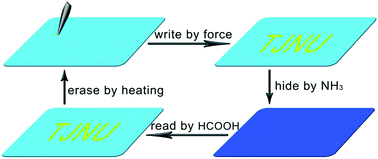Hiding and revealing information using the mechanochromic system of a 2,5-dicarbazole-substituted terephthalate derivative†
Abstract
A 2,5-dicarbazole-substituted terephthalate derivative consisting of two carboxylic acid groups was synthesized in order to investigate the influence of acidic and basic vapours on its mechanofluorochromic (MFC) behavior. UV-vis absorption and emission spectra and quantum chemical calculations indicated a molecular push–pull electronic structure and non-planar geometry, which resulted in molecular marked MFC behavior. Under mechanical force, the white solid became a yellow one and its cyan fluorescence was converted to yellow-green fluorescence. The color and fluorescence of the solid could be recovered by solvent or thermal annealing. Thus, a reversible MFC process was observed. When exposed to NH3 vapor, both the pristine and ground solids emitted blue fluorescence, and the colors of the fluorescence were restored to the original cyan and yellow-green colors by fuming with HCOOH vapor. Therefore, as a smart and multiple stimuli-responsive material, this molecule could be applied in data protection. Information written by force can be hidden using NH3 vapor, revealed using HCOOH, and then erased again using thermal annealing.



 Please wait while we load your content...
Please wait while we load your content...